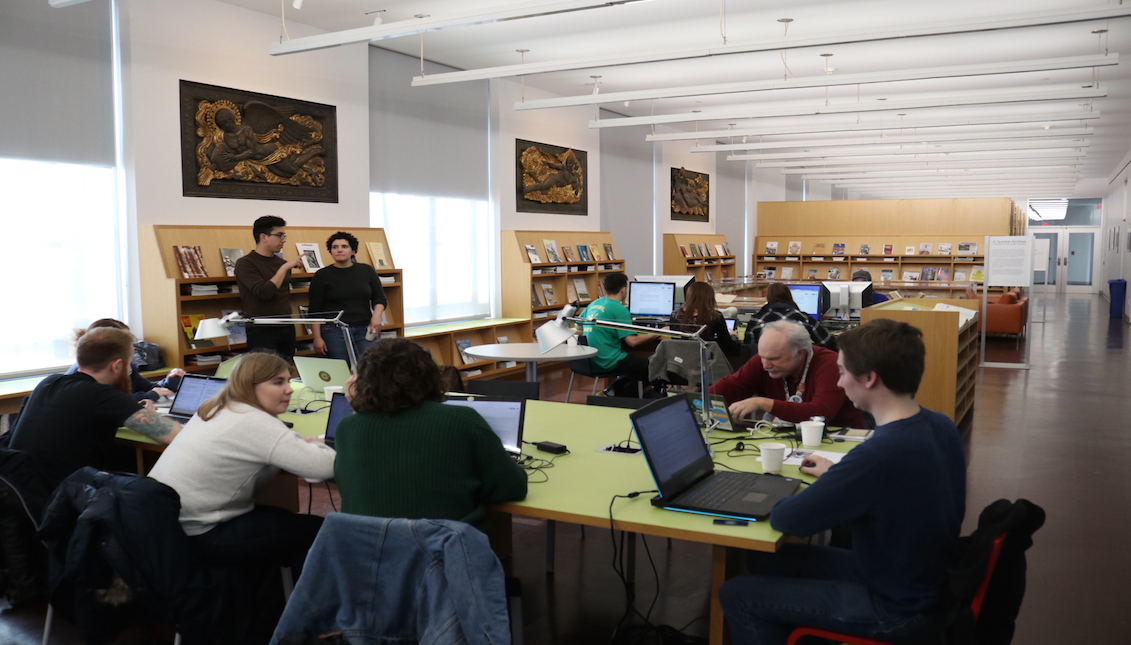
Creating conversations about Latinx art with Wikipedia
Wikipedia is the Internet’s encyclopedia, but it severely lags in Latinx art representation.
This past Saturday, the Philadelphia Museum of Art teamed up with Philadelphia’s poet laureate, Raquel Salas Rivera to conduct a six-hour editing marathon of Wikipedia. It was open to the public and focused on adding more gender fluid and Latina artists to a canon that is historically male and heterosexual.
Events of this kind began in 2014, with a campaign called Art+Feminism. Its goal is “improving coverage of cis and transgender women, non-binary folks, feminism and the arts on Wikipedia.” 2019 marks the sixth year of the campaign, and the event on Mar. 2, was the first of the year held in Philadelphia.
For Salas Rivera, it’s all about starting conversations regarding artistic standards and inclusion.
“Latinx artists feel very invisible,” said Salas Rivera. “This is another way to bring them to the fore.”
They believe these conversations need to happen in both the mainstream and Latinx art communities. Wikipedia is the perfect platform to make the information accessible to both, while also acting as an archive for future generations to build upon.
The site has long been an information source for many who grew up in the age of the Internet. For this reason, Salas Rivera stressed the importance of including Latinx artists.
“If something isn’t on the Internet, often times the information is never gained,” they said.
In 2007, a Pew study of Wikipedia users found that 44% were 18 to 29 years old. In 2019, Wikipedia topped Searchmetrics’ 2019 SEO World Rankings as the most visible website on the Internet, confirming its trust among the giants of the Internet and its almost 3.9 billion users.
Salas Rivera had to be proactive in their pursuit of influences while coming up as a young, Latinx artist. However, they recognized their privilege of access to affordable places like the University of Puerto Rico. Not every growing Latinx artist has access to such institutions, so the Internet is where they turn for inspiration.
“Seeing someone like them is validating,” said Salas Rivera.
Despite its proven viability as a source of information, to actually edit and add to Wikipedia’s database requires expert guidance. These experts are called Wikipedians and they know all the ins and outs of altering the Internet’s biggest encyclopedia.
Mary Mark Ockerbloom is the Wikipedian in residence at the Science History Institute in Philadelphia and was the expert at Saturday’s event. Ockerbloom began the event with an hour-long orientation, introducing the “culture” of Wikipedia.
“That’s often what people get tripped up on,” said Ockerbloom.
She said what people normally do on Facebook or Twitter does not fit the expectations of Wikipedia, which wants to be encyclopedic, have a neutral tone and contain verified information.
A particular challenge arose when translating Spanish articles into English ones and vice versa. In total, there are active Wikipedias in 292 different languages. For each language, Wikipedia has different editors who follow different standards when checking articles. When translating from Spanish to English, Ockerbloom and members of the group had difficulty finding comparable Spanish sources to the English ones used to verify information in the English versions.
RELATED CONTENT
“There’s always frustration around the Wikipedia platform because it’s a moving target,” said Ockerbloom. “It is improving, but there are still issues.”
However, the group setting allows Ockerbloom to observe some of the problems that manifest and respond in real time.
Another issue is Wikipedia’s overall process to recognize important artists for publication. According to Ockerbloom, the site deems an artist important if their work is featured in major museums.
“This sounds fine, but it’s not so helpful if they’re a performance artist or work on temporary big city installations. We can’t put that in a museum collection very easily, so it's hard to meet the existing notability guideline,” she said.
For Latinx artists, major museums are part of a canon they’re often excluded from.
“If you’re not part of an institution, it makes it even harder,” said Salas Rivera.
But it’s not the Latinx artists that need to realize their own exclusion. It’s those adding them to the institution as part of a Wikipedia edit-a-thon that have the most knowledge to gain about Latinx exclusion from art. In the end, Salas Rivera hopes the participants become more aware of how many Latinx artists are out there and of the difficulties they face trying to enter an industry defined by canons.
“Not all will come out of today, but it’s a glimpse,” they said.
Two more Art+Feminism Wikipedia edit-a-thons are scheduled in Philadelphia for 2019. The first is on Mar. 19 at the Tyler School of Art and the second is on April 19 at the University of Pennsylvania’s Fisher Fine Arts Library.











LEAVE A COMMENT: